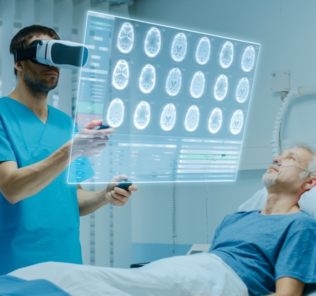Free Virtual Patient Monitor for Medical Simulation from Columbia University
Healthcare simulation has helped to shape the way medical education is provided, and one means of learning has stemmed from the use of clinical simulation software. Stemming from what he perceived as a gap in medical simulation education software accessibility, one member of the teaching faculty at Columbia University Department of Emergency Medicine set out to develop a platform that consisted of free healthcare simulation resources. For this reason, Adam Blumenberg, MD, MA, developed Med Sim Studio as a software platform that provides medical simulation educators a free and high-quality resource for in-situ simulation (in a hospital environment), remote learning (Zoom, WebEx, Skype, etc.), small groups (classroom), and sim laboratory education.
Today, this software platform allows a clinical simulation operator to provide the real-time simulation of a vital sign monitor, stimulus library (dozens of ECGs, ultrasounds, CT scans, XRs, etc.), time-stamped action log, and assessment tools. Through Med Sim Studio, all of these features are accessible with two to four mouse clicks. Not only does this allow for rapid response time, but the platform decreases interruption in the realism of the clinical simulated scenario as well.
“Med SIM Studio is a complete software platform designed for simulation educators where they can instantaneously share visual stimuli to learners,” Explained Blumenberg. “[I came up with the idea for the software because] I was frustrated with what was not available. I developed it kind of for my own use, and then also in communication with other sim educators to make it as robust and versatile as possible.”
Sponsored Content:
Further, Med Sim Studio streamlines the process of vital sign and rhythm changes on the monitor, displaying visual stimuli, and performing written evaluations. According to Blumenberg, who wrote the platform using C++, the solution is also intended to lead to better physician performance and ultimately patient outcomes. In the spirit of the humanistic practice of medicine, he relays that all that is needed to access Med Sim Studio is a Windows computer with a second monitor. Additionally, the software is easily portable and may be used in the clinical environment.
Upcoming Med Sim Studio Webinar: “A Free Open Access Virtual Patient Monitor from Columbia University Medical Center” | June 27th, 10AM PDT, UTC-7
Ultimately healthcare simulation educators can run or author pre-scripted cases, use evaluation tools, and record actions in real-time. Med Sim Studio cases are packages including all the background medical information and debrief guide related to a case, as well as all the visual stimuli (ECGs, sonograms, XRays, etc.) and vital sign pattern changes.
Med Sim Studio lets the educator author the cases and easily share them with other sim educators through a cloud database, portable media, or email. To date, the software contains over 300 high-resolution medical images, displays vital signs and waveforms (oximetry, capnography, electrocardiography, etc.), and includes incorporated attendance collection and evaluation. Additional ways healthcare simulation educators can use this resource also include:
Sponsored Content:
- Running cases: Med Sim Studio lets sim educators show vital sign changes with a click of a button, as well as other visual stimuli like radiological imaging, ECGs, and labs. Setup is easy and the software is intuitive to use.
- Teaching sim in different environments: Med Sim Studio allows educators to turn many different environments into a teaching space. Since the software can be run on either wall or battery-powered equipment, with or without an internet connection, you can teach simulation or case-based learning anywhere. For example emergency department resuscitation rooms, the ICU, clinics, offices, conference rooms, lecture halls, remote learning via Zoom/WebEx/Skype, ambulances, or outdoors.
- Feedback: Med Sim Studio streamlines formalized feedback and evaluation – both for the learners and educators. The CALM tool is embedded in the software, and educators can use it to provide meaningful feedback after each case. Additionally, through the “splash screen” feature of Med Sim Studio it’s easy to display a QR code that leads to a web-based survey – that way learners can immediately provide feedback on the learning session using their smartphones. Lastly, case authors may embed URLs to feedback surveys about their case and collect feedback from other simulation educators who are trying out their case.
- Collaboration with other educators: Med Sim Studio allows users to write and share cases. The cases can be shared directly through the Med Sim Studio software itself by clicking the “upload” button and it is immediately available to all other Med Sim Studio users. Educators can also create cases and share them directly with colleagues – the cases are saved as “.mssBundle” files in the computer’s “My Documents” folder. These files can be shared and loaded by clicking the “Load Cases” button.
“The software is really designed for anyone across the scope of simulation. This could include doctors, sim techs nurses, EMS, PAs, medical students – anyone who’s teaching medical education in a scenario that’s time-dependent,” Blumenberg said. [With Med Sim Studio], time is marching forward. You’re going through a case in real-time and you want to have vital signs that change, stimuli that change, and images that are revealed in response to learners’ questions.”
Moving forward, he shared that, as he’s been developing the solution for the past two years, all of the primary features have been successfully included within the platform. He had been launching parts of the work in product beta releases, which have gone on to be used by simulation educators from around the world.
“I’ve received emails from educators in Germany and Brazil, and have been working with some doctors in India. I’ve also been using Med Sim Studio continuously the whole time, adding features, updates, tweaks, performance improvements, and things like that,” he said. “I very recently released a final stable version. I’m sure as occasional small issues come up or new features are developed, I may release big updates every several months or years, but the current version is stable and functional.”
He added that an anesthesiologist from Germany provided some wonderful suggestions that have improved the software, for example, when the oxygen saturation decreases there is a drop in the pitch of the heart rate beeping. He also provided feedback which helped me improve the waveform displays. Regarding feedback, a software and hardware expert in Florida similarly provided excellent ideas about streamlining the file management system and compatibility of Med Sim Studio. This is “under the hood” stuff, but it makes for a much smoother experience. Further feedback has included:
-
- An Emergency Doctor from Brazil gave feedback that improved the sound effects and visual changes when charging and using the defibrillator feature.
- The team at the POCUS Atlas provided a large number of copyright-free motion picture ultrasounds which are embedded in the software.
Moving forward, Blumenberg believes that healthcare simulation will both continue in the current format (clinical simulation lab and in-situ simulation in clinical areas), as well as grow to include other spaces and modalities. For example, Med Sim Studio allows simulation to be taught inside an ambulance, or for an educator to spontaneously teach a group just by saying, “Hey log onto my Zoom meeting, we’re going to run through a case.”
“Other exciting areas of growth for healthcare simulation include virtual and extended reality sim, especially to simulate mass-casualty events and the local needs of an institution, and utilizing the skills of actors (standardized patients) to help with interpersonal skills,” he shared. “Med Sim Studio breaks down the two greatest barriers to simulation education: space and cost. The price tag for Med Sim Studio is zero, it’s completely free. Also, since it runs fine on any computer running Microsoft Windows you can use Med Sim Studio in a large variety of settings including remote learning.”
Learn More About Med Sim Studio
Lance Baily, BA, EMT-B, is the Founder / CEO of HealthySimulation.com, which he started in 2010 while serving as the Director of the Nevada System of Higher Education’s Clinical Simulation Center of Las Vegas. Lance also founded SimGHOSTS.org, the world’s only non-profit organization dedicated to supporting professionals operating healthcare simulation technologies. His co-edited Book: “Comprehensive Healthcare Simulation: Operations, Technology, and Innovative Practice” is cited as a key source for professional certification in the industry. Lance’s background also includes serving as a Simulation Technology Specialist for the LA Community College District, EMS fire fighting, Hollywood movie production, rescue diving, and global travel. He and his wife live with their two brilliant daughters and one crazy dachshund in Las Vegas, Nevada.
Sponsored Content:


















